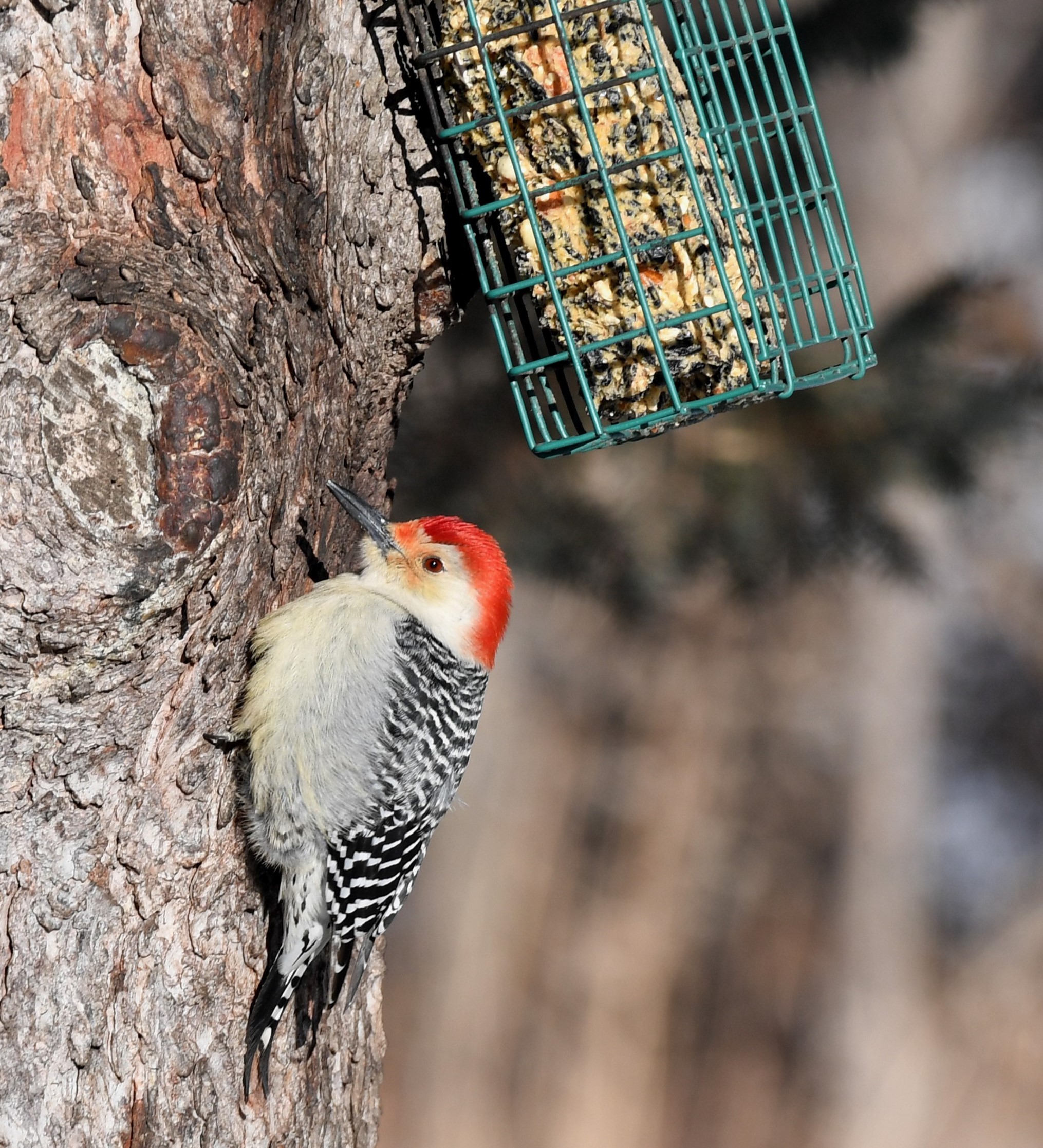There’s a lot of drumming going on at all seasons on Owl Acres. Our band consists of seven of the 23 species of woodpeckers native to North America. When we put up our birdfeeder this winter, one of our first visitors was a red-bellied woodpecker come to investigate the new food. He didn’t stay long and has been back often since then, pushing smaller birds out of the way but deferring to the mighty blue jay.
Mr. Redbelly does have a wash of red on his belly, but it’s not readily apparent most of the time. He has a more recognizable black and white zebra striping on his back, tail and wings, and white patches near his wingtips. He also has a red stripe that begins above his bill and goes up and over his head to the nape of his neck. His face and belly are otherwise a light gray. Mrs. Redbelly is similarly marked except that the red on her head is only on the nape of her neck.
I think we’re all familiar with that jackhammer drumming that woodpeckers do. But have you ever wondered how a woodpecker can move that fast, slam its bill that hard, and not end up with traumatic brain injury? The solution is evolution. Woodpeckers have evolved several characteristics that differentiate them from other birds and allow them to drum on hollow trees without losing their balance or causing brain injury.
Scientists and everyone else thought, up to a couple of years ago, that the reason woodpeckers could beat their heads against trees 20 times a second with force up to 1200G was that the spongy bones in their heads acted like shock absorbers. Turns out this is not true. The beak and head act together to make a solid hammer. It wouldn’t make sense, a new study found, to use a hammer with a shock absorber. Any carpenter knows that a hammer with a shock absorber would be very inefficient. So the bird’s beak and head work together to deliver blows to excavate insects and nest cavities. But what about brain damage? Here are three scientific theories. (1) It’s a matter of scale. The birds and Their brains are quite small and being small actually protects the brain. Plus, the brain’s position in the skull protects it from harm. (2) Each strike sets up harmonics in the skull that are at their lowest point when they reach the brain. And (3), they do get brain damage. It just takes a while. Scientists don’t agree which theory is correct, so we’ll just keep wondering.
Another set of adaptations are necessary for the woodpecker to hammer its bill on a tree and not fall off. Three factors work together to create the stability the bird needs. First, it has stiff tail feathers that it can lean on for balance. Second, it has four toes on each foot. Two toes point forward, and two point backward, giving the bird the ability to grip the tree trunk. And the third factor is the unusually strong leg muscles it uses to hold it in place.
Woodpecker hunts for food in crevices in tree bark, so it has to reach its tongue deep into the cracks to get at the food. Happily, three adaptations of its tongue make this easy for the bird. First, the woodpecker has a very long tongue as birds go. Its tongue can reach two inches or more beyond its bill, so it can reach deep into those cracks. Second, Its saliva is very sticky, so small arthropods like ants and beetle larvae stick to it like flypaper. And third, its cylindrical tongue has a spear-like tip and a barb that it can use like a fish hook to grab and haul out its prey. When it’s not eating, it can reel in and store its tongue using specialized structures in its head.
So Mr. Red-belly is well equipped to do all that drumming and pounding. But why does he do it? First of all, he does it to get at insects and other small critters hiding under bark or in cracks in rotting wood. After mating in the early spring, Mr. and Mrs. Redbelly will use their chisel-shaped bills to hollow out a nest cavity. She will lay and incubate her eggs on the bed of woodchips left over from the excavating. Other birds and squirrels will use these cavities after the woodpeckers are done with them. In some cases, European starlings may come along and kick them out and take over the nest cavity for themselves.
The third reason he does all that drumming is to communicate. Along with having special songs to woo and court his mate, woodpeckers use drumming for their territorial displays. They have several calls, and Mr. Red-belly has a characteristic laugh as well, but the drumming on the most resonant surfaces such as hollow logs is an important part of his repertoire.
Red-bellied woodpeckers don’t migrate. They’ll stay around all winter, drumming and calling and patrolling the bird feeder.
Photo by Eric LaPrice. Alt text: Bird with red crown (indicating male), tight white and black stripes in back and fluffy light grey breast, clings to a tree trunk, inspecting the suet feeder overhead. Red Bellied Woodpecker.
